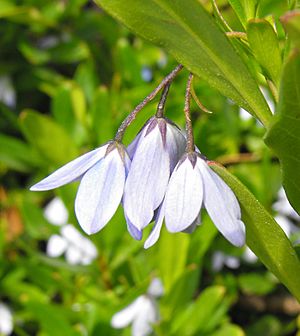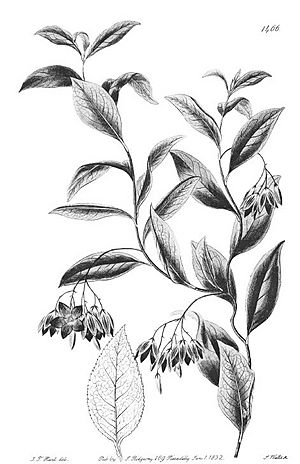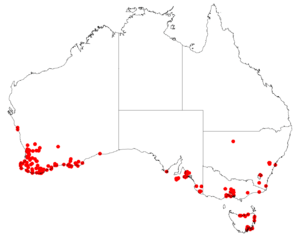Bluebell creeper facts for kids
The bluebell creeper (scientific name: Billardiera heterophylla) is a beautiful flowering plant from the Pittosporaceae family. It used to be called Sollya heterophylla. This plant is originally from Western Australia. People grow it all over the world because it's very pretty. Sometimes, it escapes from gardens and grows wild, like in other parts of Australia and in California. Because it spreads easily, some people consider it a weed.
Quick facts for kids Bluebell creeper |
|
|---|---|
 |
|
 |
|
| Lectotype | |
| Scientific classification | |
| Genus: |
Billardiera
|
| Species: |
heterophylla
|
 |
|
| Occurrence data from AVH | |
| Synonyms | |
|
Labillardiera fusiformis Schult. |
|
Contents
What Does the Bluebell Creeper Look Like?
The bluebell creeper is a climbing shrub. Its branches twist around other plants to help it grow upwards. The leaves are shiny green on top. They can be from 10 to 60 millimeters long and 2 to 22 millimeters wide.
Flowers and Fruit
The plant has single flowers or small groups of up to five flowers that hang down. Each flower has five petals, about 1 centimeter long. These petals can be white, deep blue, or even pinkish.
After the flowers, the plant grows berries. These berries can be up to 3 centimeters long. They have soft, pulpy flesh and many seeds inside. When they are young, the purplish-green, sausage-shaped fruits are hairy. But as they get older and ripen, they become smooth.
How Was This Plant Named?
The bluebell creeper was first described in 1831 by an English botanist named John Lindley. He called it Sollya heterophylla. Later, in 2004, scientists Cayzer, Crisp, and Telford moved it to a different group, the Billardiera genus.
Meaning of the Name
The second part of its scientific name, heterophylla, means "with various or diverse leaves." This is because its leaves can look a bit different from each other. Besides bluebell creeper, people also call it the Australian bluebell or climbing bluebell.
This plant is closely related to two other species from Western Australia: B. fusiformis and B. drummondii.
Where Does the Bluebell Creeper Grow?
Billardiera heterophylla naturally grows in the southwest parts of Western Australia. You can find it in open forests with eucalyptus trees and in woodlands. It also grows in coastal areas and near salt lakes further inland. This plant is very good at growing in places that have been disturbed, like after a fire.
Because people grow it so much and it spreads easily, it's sometimes hard to know exactly where it originally grew in the wild.
Why is it Grown and Why is it a Weed?
The bluebell creeper is a very popular garden plant. It has been grown in gardens around the world for over 100 years. Seeds were even available in Jamaica as early as 1887!
Spreading as a Weed
In some parts of Australia, like Victoria, South Australia, and Tasmania, it has become a serious environmental weed. This plant makes a lot of seeds. These seeds grow easily after a fire or when the ground is disturbed. It's also thought that native animals help spread the seeds by eating the fruit. This not only moves the plant to new places, but the seeds also grow better after being eaten.
In 2013, this plant received the Royal Horticultural Society's Award of Garden Merit. This award means it is an excellent plant for gardens.

